| Article ID | Journal | Published Year | Pages | File Type |
|---|---|---|---|---|
| 5041761 | Consciousness and Cognition | 2017 | 8 Pages |
â¢Visual compared to auditory and olfactory autobiographical memories involved higher constituents for the self.â¢Positive autobiographical memories increased from olfactory to auditory to visually cued autobiographical memories.â¢Negative autobiographical memories decreased from olfactory to auditory to visually cued autobiographical memories.â¢Positive compared to negative affective states were more involved in autobiographical memory.
Given that autobiographical memory provides a cognitive foundation for the self, we investigated the relative importance of visual, auditory and olfactory autobiographical memories for the self. Thirty subjects, with a mean age of 35.4 years, participated in a study involving a three Ã three within-subject design containing nine different types of autobiographical memory cues: pictures, sounds and odors presented with neutral, positive and negative valences. It was shown that visual compared to auditory and olfactory autobiographical memories involved higher cognitive and emotional constituents for the self. Furthermore, there was a trend showing positive autobiographical memories to increase their proportion to both cognitive and emotional components of the self, from olfactory to auditory to visually cued autobiographical memories; but, yielding a reverse trend for negative autobiographical memories. Finally, and independently of modality, positive affective states were shown to be more involved in autobiographical memory than negative ones.
